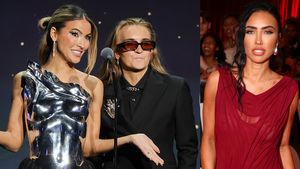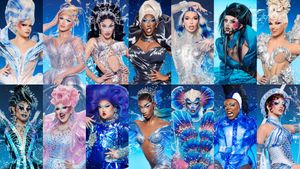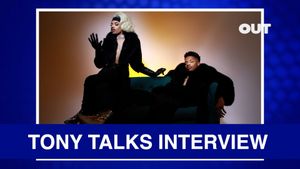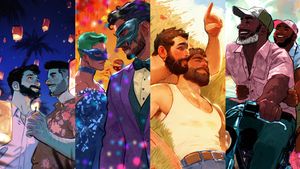CONTACTAbout UsCAREER OPPORTUNITIESADVERTISE WITH USPRIVACY POLICYPRIVACY PREFERENCESTERMS OF USELEGAL NOTICE
© 2025 Equal Entertainment LLC.
All Rights reserved
All Rights reserved
Scroll To Top




































By continuing to use our site, you agree to our Private Policy and Terms of Use.
Discover the origins and meanings of these 36 Pride flags
36 Queer Pride flags you should know

How many Pride flags are out there?
Whether you're celebrating Pride in New York, Madrid, or Tel Aviv, you'll be seeing all sorts of queer flagging. There’s a yellow, white, purple, and black flag. There’s a pink, green, and blue Pride flag. There’s also a pink, yellow, and blue flag. There’s even a flag with a bear paw print. But what do these flags and colors and designs represent?
There are many sexualities and genders within the LGBTQ+ community, and we've identified 36 of the flags that represent them, explained the meaning of the designs and colors in Pride flags, and even identified the creator and the original posts to social media introducing the new LGBTQ+ flags.
Keep scrolling to see our Pride flags list.
Gilbert Baker Pride Flag

In 1977, Harvey Milk asked Gilbert Baker, a self-taught sewer and veteran and sometimes heralded as the ‘gay Betsy Ross,’ to create a symbol of pride for the gay community. He decided on a Pride flag, but what did that mean? The breakthrough idea came to him while dancing to a band at San Francisco’s Cow Palace.
“We were all in a swirl of color and light," Baker wrote in his autobiography, Rainbow Warrior: My Life in Color. "It was like a rainbow. A rainbow. That's the moment when I knew exactly what kind of flag I would make."
The original Gilbert Baker Pride flag flew at the San Francisco Gay Freedom Day Parade celebration on June 25, 1978, where Harvey Milk gave his famous “Hope Speech” on the ninth anniversary of the Stonewall Riots.
While some claim Baker had help from artist Lynn Segerblom and volunteer James McNamara, others staunchly say it was his own creation. Regardless of the controversy, the flag’s symbolism remains as relevant today as it was when it debuted in 1978.
The flag's colors were inspired by Judy Garland's iconic song and one of many unofficial gay anthems, "Over the Rainbow." Here are the meanings of each color assigned by Baker in his original Pride flag:
Hot pink = Sex
Red = Life
Orange = Healing
Yellow = Sunlight
Green = Nature
Turquoise = Magic/Art
Indigo = Serenity
Violet = Spirit
1978-1999 Pride Flag

Following the assassination of Harvey Milk and Mayor George Moscone by Dan White on November 27, 1978, many in the community wanted their own Pride flag to honor the slain activist’s memory and accomplishments, and they wanted them in time for The City’s 1979 Gay Freedom Day Parade. Baker was unable to meet the new demand for flags, so he teamed with the since-closed Paramount Flag Company (on 9th Street in what is now the Leather and LGBTQ Cultural District) to help with production and distribution.
But there was just one problem.
It turned out that hot pink was not in hot demand, meaning there wasn’t enough hot pink fabric to make the flags. This led Baker and the Paramount Flag Company to create the Traditional Gay Pride Flag, which was just the Gilbert Baker Pride Flag without the hot pink stripe.
Traditional Gay Pride flag

The most recognizable Pride flag now is the Traditional Gay Pride flag, the six-color version (minus hot pink and turqouise) that was adopted by the community in 1979..
Numerous complications arose within the community regarding the use of the Traditional Gay Pride Flag in the upcoming 1979 Gay Freedom Day Parade in San Francisco. Some reports said the odd number of stripes left parade organizers upset because they were unable to evenly divide the colors on both sides of the street (three colors decorating one side of the street, and three on the other). Other reports cited the same problem, but said it was related to hanging evenly divided colors from lampposts along the parade route.
The solution? Drop the turquoise along with the hot pink for a flag with an even number of stripes just in time for the 1979 Gay Freedom Day Parade. And voila, the Traditional Gay Pride Flag was born.
Philadelphia People of Color-Inclusive Pride flag

The Philadelphia People of Color-Inclusive Pride flag took the Traditional Gay Pride flag and added black and brown stripes at the top to represent queer people of color.
The catalyst for the change was the release of a 21-second video recorded on an iPhone showing Darryl DePiano, operator of the ICandy nightclub in Philadelphia's gayborhood, using an offensive racial epithet to disparage people of color.
“Ni-ni-ni-ni-ni----s, every one of 'em,” DePiano is heard saying on the video, claiming that only people of color ask for free drink tickets.
The video went viral and led to protests about racism within the City of Brotherly Love’s LGBTQ+ community. In response, community leaders added the black and brown stripes to represent Black and Latino gays. The black stripe also honors those who passed during the HIV/AIDs epidemic of the 1980s and ’90s.
While some criticized the addition of the colors and argued that the rainbow flag is inclusive and race-neutral, the new design quickly gained acceptance in the larger community, particularly after celebrities like Lena Waithe were seen with the Philadelphia People of Color-Inclusive Pride flag.
Progress Pride flag

The new Progress Pride flag, designed by Daniel Quasar in 2018, takes Philadelphia's inclusive Pride flag one step further. Quasar’s design incorporates the white, pink, and light blue colors from the Transgender Pride Flag, while the brown and black stripes of the Philadelphia People of Color-Inclusive Flag represent people of color and those lost to AIDS.
"When the Pride flag was recreated in the last year to include both black/brown stripes as well as the trans stripes included this year, I wanted to see if there could be more emphasis in the design of the flag to give it more meaning," Quasar, who identifies as queer and nonbinary, explained on his Kickstarter.
The new flag gained immediate acceptance in the LGBTQ+ community. The Progress Pride flag was flown in front of London’s city hall during London Pride 2019. In 2020, a bespoke applique version of the flag was acquired and displayed by the famed Victoria and Albert Museum in London.
Intersex-Inclusive Progress Pride flag

The new Progress Pride flag, designed by Daniel Quasar in 2018, takes Philadelphia's inclusive Pride flag one step further. Quasar’s design incorporates the white, pink, and light blue colors from the Transgender Pride Flag, while the brown and black stripes of the Philadelphia People of Color-Inclusive Flag represent people of color and those lost to AIDS.
"When the Pride flag was recreated in the last year to include both black/brown stripes as well as the trans stripes included this year, I wanted to see if there could be more emphasis in the design of the flag to give it more meaning," Quasar, who identifies as queer and nonbinary, explained on his Kickstarter.
The new flag gained immediate acceptance in the LGBTQ+ community. The Progress Pride flag was flown in front of London’s city hall during London Pride 2019. In 2020, a bespoke applique version of the flag was acquired and displayed by the famed Victoria and Albert Museum in London.
Queer Pride flag

The Queer Pride flag was designed by DeviantArt user pastelmemer, a self-described “digital furry artist and queer content creator,” in 2015.
The flag melds multiple aspects of queerness. Human Rights Campaign explains the pink and blue colors honor “same-gender attraction while the orange and green stripes represent non-binary and gender non-confirming individuals. The black and white stripes symbolize asexual, aromantic, and the agender community."
The earliest extant photograph showing the Queer Pride flag on display was taken in Kalamazoo, Michigan, and posted to Unsplash on July 5, 2019. The flag has also appeared in a number of displays and Pride events in the U.K. and The Netherlands.
Queer People of Color Pride flag

The creator and origins of the Queer People of Color flag are unknown. The flag takes the six-striped Traditional Gay Pride flag and adds a multi-colored, raised, clenched fist set against a black, circular background, symbolizing the intersection between the fights for racial and queer equality.
The Queer People of Color flag was first flown at San Francisco Pride in 2019, but gained greater appreciation and recognition during the Black Lives Matter movement of 2020 and beyond. The flag symbolized for some the melding of the civil rights and LGBTQ+ liberation movements.
“The modern LGBTQ+ liberation movement was touched off by queer and trans people of color and their struggle continues to this day, with both communities seeking justice, equality, and freedom from oppression. And because many people belong to both communities, they’re not two distinct causes but instead overlap,” Matt Baum wrote in Them in 2021. “In other words, it’s great to honor the fight for civil rights by flying a flag; but even better to honor that fight by taking part and fighting for equality for all.”
Bisexual Pride flag

Designed by Michael Page, the Bisexual Pride flag brings visibility to the bisexual community by overlapping the stereotypical colors for boys and girls. The flag was inspired by an older symbol of bisexuality: the "biangles," two overlapping pink and dark blue triangles designed by Liz Nania for the first national bisexual contingent for the 1987 March on Washington..
“To me, this new BiPride Flag will give Bi People the visibility necessary to invoke the presence we have at many GLBT events, but never had managed to effectively manifest in the past,” Page explained in an email to CRW Flags in 1999.
The Bi Pride flag was first flown in 1998 at BiCafe’s first Anniversary Party. Controversy arose when BiNet USA claimed copyright over the design and tried to stop people from using it without a paid licensing agreement. The resulting backlash from the bisexual community forced the organization to change its leadership.
Pansexual Pride flag

Little is known about the origins of the Pansexual Pride flag other than that it first circulated online in 2010. The flag’s colors represent pansexuality's interest in all genders as partners.
“The pink stripe represents attraction to women while the blue stripe represents attraction to men,” according to the Human Rights Campaign. “The yellow stripe is for everyone else in-between and beyond the gender binary.”
The flag began flying at Pride events some years later, including Washington D.C.’s Capital Pride in 2016. The following year, the Pansexual Pride flag appeared at Pride events in Milan, Paris, Bourne, and London in Europe, and Erie, Penn., and Atlanta in the U.S.
Asexual Pride flag

Like the Pansexual Pride flag, the Asexual Pride flag was created in 2010. Inspired by the Asexual Visibility and Education Network’s logo, the design represents many ace identities, including graysexuals (the fluid area between sexuals and asexuals) and demisexuals (people who don't experience sexual attraction unless they have an emotional connection with their partners).
“Black represents asexuality, gray means gray-asexuality and demisexuality, whites stands for non-asexual partners and allies, and the purple represents community,” according to the Human Rights Campaign.
The Pansexual Pride flag was displayed the following year at Pride events in Stockholm, Sweden, Manchester, U.K., and San Francisco.
Labrys Lesbian Pride flag

Oddly enough, this sapphic symbol was not designed by a lesbian, or even a woman. Gay graphic designer Sean Campbell created the Labrys Lesbian Pride flag featuring a labrys, an ax-like weapon used by Grecian amazons and also a symbol of some lesbian feminist groups of the 1970s. The inverted black triangle is symbolic of the patch used by Nazis to identify lesbians and other “asocial” individuals, while purple has been associated with lesbians beginning in ancient Greece.
Perhaps due to its male origins, the flag has not gained much traction in the lesbian community.
Polyamory Pride flag

Featuring the symbol for the infinite number pi (which also conventiently shares the first letter of "polyamory"), the Polyamory Pride flag celebrates the infinite selection of partners available to polyamorous people. Designed by Red Howell, it was adopted in 2021 when 30,000 members of the polyamorous community voted their approval.
The Polyamory Pride flag “represents elements around different core values including white for possibility, magenta for desire and love, blue for openness and honesty, gold for energy and perseverance and purple representing the united non-monogamous community,” according to the Human Rights Campaign.
The first known displays of the flag took place in Malmö, Sweden, in August 2017, and Tel Aviv, Israel, the following year.
Intersex Pride flag

Morgan Carpenter, co-chair of Intersex International Australia, designed the Intersex Pride flag in 2013 to celebrate folks living outside the binary. Carpenter chose yellow and purple as the sole colors for the flag because they are generally considered to be gender-neutral.
The earliest known use of the flag at a Pride event took place at Taiwan Pride 2015.
Transgender Pride flag

Monica Helms, a trans woman, designed the Transgender Pride flag in 1999, and it first flew a year later at Phoenix Pride.
“One day, I woke up with the idea for the colors—the traditional color, light blue, for boys, pink for girls, and a single white stripe for those who are transitioning, gender neutral, or intersex,” Helms told Atlanta Magazine in 2020. “I took it to protests, marches, funerals, transgender days of remembrance.”
Helms reported the flag proved instantly popular, and the Transgender Pride flag was flown officially for the first time at a Pride Parade in Phoenix in 2000.
Genderfluid/Genderflexible Pride flag

The Genderfuid/Gendeflexible Pride flag was revealed in a post to the Genderfluidity Tumblr blog by creator JJ Poole in August of 2012.
“So I couldn't find a flag that represented gender-fluidity, so since I was working on other projects for most other gender identities and sexual orientations for my store, I figured i would make one,” Poole wrote in the post. “I was hoping to get some opinions, and if it's a good one, for it to get around.”
Encompassing the fluctuations and the flexibility of gender in genderfluid people, the flag features colors associated with femininity, masculinity, and everything in between. The pink stands for femininity. The white represents the lack of gender. The purple represents the combination of masculinity and femininity. The black symbolizes all genders, including third genders. The blue reflects masculinity.
Genderqueer Pride flag

The Genderqueer Pride flag was created in 2011 by self-described “filmmaker, photographer, and bot-maker” Marilyn Roxie (@maryilynroxie).
“I had been struggling with my identity a lot and wanted to create a flag when I realized there wasn’t one. I started with thinking about lavender and went from there,” Roxie told The Buzz Magazine in 2015. “It went through a few versions with lettering and then different colour arrangements, but I am happy with its appearance now.”
The Genderqueer Pride flag highlights androgyny with lavender, agender identities with white, and nonbinary people with green. Some people who feel queer is a slur, refer to it as the Nonbinary Pride flag.
Lipstick Lesbian Pride flag

If you want the most feminine pride flag, here it is. The Lipstick Lesbian Pride flag was created by Nancy McCray in 2010 and first posted to her since-deleted This Lesbian Life blog. The flag celebrates the femmes in the lesbian community, sometimes lovingly and sometimes not referred to as "lipstick lesbians."
The Lipstick Lesbian Pride flag is not without controversy due to transphobic and racially offensive comments posted by McCray to the now defunct blog.
Lesbian Pride flag

Following the fallout from the accusations of transphobia and racism from the creator of the Lipstick Lesbian Pride flag, a new Lesbian Pride flag was posted to social media in 2018. Creator Lydia explained the inspiration for the flag came from the poet Sappho.
“Sappho describes her lover as wearing violets, rosebuds, dill and crocuses,” Lydia wrote in Medium in 2018. “Reading this, it was like a puzzle came together in my head, all at once.”
The dark orange stripe represents gender non-conformity, the orange stripe represents independence, the light orange stripe represents community, the white stripe represents unique relationships to womanhood, the pink stripe represents serenity and peace, the dusty pink stripe represents love and sex, and the dark rose stripe represents femininity.
A narrative has emerged that this flag is more inclusive of butch and trans lesbians, though debate on that issue continues to this day.
Leather, Latex, & BDSM Pride flag

Whether the kink community should be added in the acronym LGBTQ+ is a heated debate, but this particular community is well represented when it comes to Pride flags. This Leather Pride flag was designed by the late Tony DeBlase for Chicago's International Mr. Leather celebration in 1989 (the title was won that year by Guy Baldwin). These various flags are not exclusively gay, but rather for the leather and BDSM community. DeBlase’s original Leather Pride flag is on display at the Leather Archives and Museum in Chicago.
International Bear Brotherhood Pride flag

The International Bear Brotherhood Pride flag was designed by Craig Byrnes in 1995 for the International Bear Brotherhood. Byners was a familiar figure in the bear subculture, having been heralded as Mr. Baltimore Bear Club (1993) and Mr. Teddy Bear Leather of Virginia (1994), and appeared wearing only his natural fur in American Grizzly and American Bear magazines.
While the colored stripes on other Pride flags have generally deeper meaning, the colors of this flag were chosen because they match the fur of (four-legged) bears. If you didn’t get the point, a black bear paw print is imposed on the upper left-hand portion of the flag, partially covering four stripes.
A version of the International Bear Brotherhood Pride flag without the bear paw print is reportedly popular in Mexico, and has appeared at multiple Pride events in Mexico City, Gualdalaja, and elsewhere.
Rubber Pride flag

The Rubber Pride flag, also known as the Latex Pride flag, was created by Peter Tolos and Scott Moats in 1995. The pair said they designed the flag to identify “like-minded men” and that the design “reflects the sensory, sensual, and mental passion we have for rubber." They said the black color represents "our lust for the look and feel for shiny black rubber," the red symbolizes "our blood passion for rubber and rubbermen," while yellow highlights "our drive for intense rubber play and fantasies."
And just in case you needed another hint, the Rubber Pride flag features a literal kink in its stripes. Get it?
Polysexual Pride flag

The Polysexual flag was revealed in a 2012 post by user Samlin to their since-deleted Tumblr blog.
“I, as a poly individual, was greatly saddened by the fact that we don’t have a flag…so I made one :P I made it similar to the bi and pan flags, since they’re all in under the multisexual umbrella,” Samlin wrote in the post. “If people want to use it-great! If not-that’s fine too. I just thought I’d share in case anyone was interested.”
Polysexuality, unlike pansexuality, is the attraction to multiple genders but not all. A middle ground between bisexuality and pansexuality, it is centered more around attractions to femininity and masculinity rather than gender itself. The pink of the Polysexual flag represents attraction to females, the blue for males, and the green is for an attraction to folks who don't conform to either gender.
Agender Pride flag

The Agender flag was created by Salem X and first posted to their Transrants Tumblr blog in 2014. The black and white stripes represent the absence of gender, while green, the inverse of the gender-heavy purple, represents nonbinary genders.
“I am so incredibly proud to see how far the Agender flag has gone, and I am also grateful to have evolved so much as a person since hosting this blog,” Salem X wrote in the last post to the blog in 2019, adding, “Please use the flag how you see fit.”
Aromantic Pride flag

Tumblr user Cameron Whimsy created the Aromantic flag and posted it to their blog in November of 2014.
“The flag is basically divided into three sections – with the top pair of colors and the bottom pair of colours being two spectrums,” Whimsy wrote in a blog post explaining the meaning of the flag.
The Aromantic flag uses shades of green to celebrate the people who live without romantic attraction. The black and grey stripes represents “the sexuality spectrum - acknowledging aro-aces, aromantic allosexuals, and everything in between because we are a diverse lot,” Whimsey continued, adding that the white stripe represents the platonic dividing line between the two spectrums.
Nonbinary Pride flag

Created by 17-year-old Kye Rowan and first posted to Tumblr blog in 2014, this flag was a response to nonbinary people feeling improperly represented by the genderqueer flag.
“Not all nonbinary people identify as genderqueer, and them using a flag that has largely become synonymous with “genderqueer” is uncomfortable and forces them under a label they do not want,” Rowan explained in a blog post.
The yellow symbolizes gender outside a binary. The white, a mix of all colors, represents those with many or all genders. Purple stands in for those who feel both binary male and female or fluid between them. The black is for the agender community, without sexuality or color.
Rowan was emphatic that the Nonbinary flag does not replace the Genderqueer flag.
“I love the genderqueer flag,” Rowan wrote in the blog post. “ I intend it to sit along side the other, not replace it! I personally, will be using both as I am a genderqueer nonbinary,”
Pony Pride flag

Carrie P created the Pony Pride flag in 2007 using the color black in solidarity with the leather community at large. Pony play is a distinct fetish where people are treated like horses by wearing hooves, ears, and saddles and pulling carts.
While pony play might not have made it into the mainstream, the Pony flag is available for purchase at Walmart.
Straight Ally Pride flag

The creator and origins of the Straight Ally Pride flag are unknown, but it first started appearing at Pride events in the early 2000s. The flag makes everyone feel included at Pride marches, even if they're celebrating other people's sexualities.
Butch Lesbian Pride flag

Created in 2016 by Tumblr user dorian-rutherford, the Butch Lesbian flag is meant to represent lesbians who don't identify with the Lipstick Lesbian flag, according to the University of Northern Colorado. While the color's symbolism remains unknown, people believe the blue represents masculinity, the white represents people across the gender spectrum, and the purple represents lesbians and those who identify as women.
Two Spirit Pride flag

The two feathers of the Two Spirit flag represent both masculine and feminine identities, while the circle represents the combination of the masculine and feminine into a single identity. Before Europeans colonized indigenous lands in North America and enforced a gender binary, many Native American tribes recognized a third gender which is today called two spirit.
Twink Pride flag

The Twink Pride flag features a pink top and yellow bottom and two Mars signs intertwine representing gay men. The origin of the flag is unknown, much like the origin of the word "twink." The term refers to slim, young, handsome, hairless men. It may come from the British slang "twank," which referred to a client of a gay sex worker, according to The New York Times. Others say it's from the Hostess snack, the Twinkie. Both explanations are delicious.
Demigirl Pride flag

The Demigirl flag was created by Tumblr user Transrants in 2015 and represents those who identify as either demigender or as a demigirl. Demigirls are those who identify partially as women.
Demiboy Pride flag

The Demiboy flag was also created by Tumblr user Transrants in 2015. The flag is a symbol for those who identify as either demigender or as a demiboy. Demiboys are those who identify partially as men.
“This means someone identifies partially as a man, but not fully,” according to the University of Washington. “Their gender is 'man-adjacent.’”
The blue stripes symbolize masculinity and manhood, the white stripes symbolize agender and non-binary identities, while the grey stripes symbolize partial connections and grey areas.
Neutrois Pride flag

Like many other Pride flags, the exact origins of the Neutrois flag are unknown. As the color scheme of black, green, and white appears to be based upon (or in response to) the Genderqueer Pride flag, some have speculated the Neutrois flag must have been created after 2011 when the Genderqueer Pride flag was unveiled.
The Neutrois flag represents those who identify as gender neutral. as gender neutral. While some may use neutrois and agender interchangeably, others say a distinction lies in that neutrois-identifying people still have some sense of gender identification. The white stripe represents neutrality, the green represents something outside pink and blue, and the black stripe represents genderlessness.
Bigender Pride flag

The Bigender pride flag represents those who identify as two genders, whether male and female or some combination of non-binary identities. Bigender Pride Day is celebrated on June 17th.
Trans-Inclusive Gay Men's Pride Flag

It might be difficult to keep track of the most recent and preferred Trans-Inclusive Gay Men's Pride flag, as there are at least 20 known variants of the flag. This version was designed to be inclusive of non-cisgender gay men.
Per its creator, the white stripe in the center is adopted from the Trans Pride flag. The other stripes and colors represent community and joy in nature, fortitude and diversity in “presentation, relationships, and life experience.”
“I decided to have a light blue stripe leading into a deep purple to symbolize how some of us might be stereotypical, some of us might not be, and some of us are in-between or fluid,” the creator posted to their blog. “Regardless, we should all be celebrated and respected.”
Latest Stories
Redefining LGBTQ+ luxury at sea: Virgin Voyages' Resilient Lady experience
February 25 2025 8:24 AM
Join the fun at Whistler Pride 2025
January 09 2025 3:00 PM
Explore dushi Curaçao: Your colorful LGBTQ+ Caribbean oasis
December 16 2024 1:45 PM
Gay blind traveler Henry Martinez embraces Greater Fort Lauderdale in his latest video
December 06 2024 4:36 PM
Which trans beauty will steal the spotlight at Miss International Queen – USA?
November 23 2024 10:39 AM
Naughty holiday cheer as Santa's Secret lands in West Chelsea
November 15 2024 2:25 PM
No Pride flags needed in French Polynesia
April 07 2025 11:16 AM
Take a long, hard look at the Real Nasty Pigs of New York
January 14 2025 4:20 PM
Get ready to unleash your kink at MAL Weekend 2025
January 07 2025 3:14 PM
Get ready for Aspen Gay Ski Week 2025
December 23 2024 4:24 PM
KUST. unveils 'Thong 01' just in time to stuff for the holidays
November 20 2024 5:45 PM
BOYS! BOYS! BOYS! opens new Gallery Café in London
November 06 2024 4:45 PM
Out and About with Karan Soni
April 04 2025 8:00 AM
Jane Hilton's 'Cowboys & Queens' captures the modern American dream
March 28 2025 6:27 PM
Discover why Thailand is the ultimate LGBTQ+ paradise
January 14 2025 10:00 AM
French Polynesia LGBTQ+ island hopping guide
January 07 2025 8:15 AM
Out and About with Billy Eichner
December 20 2024 3:25 PM
31 Period Films of Lesbians and Bi Women in Love That Will Take You Back
December 09 2024 1:00 PM
Discover the LGBTQ+ paradise of San Juan, Puerto Rico
November 29 2024 9:30 AM
Trending stories
Recommended Stories for You





































































